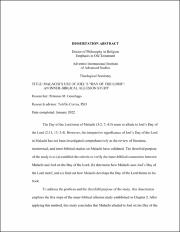| dc.description.abstract | The Day of the Lord texts of Malachi (3:2, 7; 4:5) seem to allude to Joel’s Day of
the Lord (2:11, 13; 3:4). However, the interpretive significance of Joel’s Day of the Lord
in Malachi has not been investigated comprehensively as the review of literature,
intertextual, and inner-biblical studies on Malachi have validated. The threefold purpose
of the study is to (a) establish the criteria to verify the inner-biblical connection between
Malachi and Joel on the Day of the Lord, (b) determine how Malachi uses Joel’s Day of
the Lord motif, and (c) find out how Malachi develops the Day of the Lord theme in his
book.
To address the problem and the threefold purpose of the study, this dissertation
employs the five steps of the inner-biblical allusion study established in Chapter 2. After
applying this method, this study concludes that Malachi alluded to Joel on his Day of the
Lord as indicated by these lexical coordinates: וּ יִ מ (but who) and כ לו (endure; Joel 2:11,
Mal 3:20 שׁבוּ ;וּ (return; Joel 2:13, Mal 3:7); יוֹ ם יהְ והָ ה גַּדָ וֹל והְ נַּוֹראָ (the great and the fearful
day of the Lord; Joel 2:31 [MT 3:4], Mal 4:5 [MT 3:23]); ה יֵהםֶ y אַיֵּ ה א ֱ (where is their God)
and ה יֵ המַּשִׁ פְּ ט y אַיֵּ ה א ֱ (where is the God of the judgment; Joel 2:17, Mal 2:17); בְּרכָהָ
(blessing) and מִנחְהָ (offerings; Joel 2:14; Mal 3:3, 10); and י ב שׁ (sit) and שָׁפטַ (judge; Joel
3:12; Mal 3:3, 5) and as verified by these criteria for validation: the volume of parallels
and the frequency and distribution of the shared lexemes. Applying step 1 concretizes
Malachi’s allusion on Joel’s Day of the Lord.
To proceed with the second and third purposes, steps 2 to 5 have been observed,
namely: determine the direction of dependence between texts, delimit the passage where
the allusion is found in both Malachi and Joel, exegete both passages to find out the
interpretive significance of the allusion from the earlier text to the alluding text, and
ascertain the development of the allusion in the alluding text.
This study concludes that Malachi has saturated himself with the message of the
book of Joel on the Day of the Lord. His allusions to it extends the powerful message of
Joel to the audience of Malachi. However, Malachi develops more the Day of the Lord
theme in his book. He starts with Edom’s Day of the Lord as historical fulfillment, where
Joel ends his book looking forward to it. From this historical fulfillment of Edom’s
desolation (Mal 1:2–5), Malachi moves to the future orientation of the Day of the Lord,
which looms upon Yehud (Mal 3:1–7) and the Earth (Mal 4:1–6).
Malachi’s allusion on the Day of the Lord has been enriched when the earlier
source is considered. Thus, this method (inner-biblical allusion) can also be used in
analyzing other themes in the book of Malachi as it alludes to other books of the OT. It
will be helpful to understand Malachi’s use of Scriptures in other motifs through the
inner-biblical allusion study. Finally, this method can also be applied to other allusion
studies from one book to another. | en_US |

